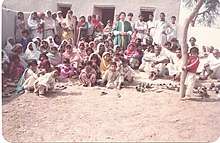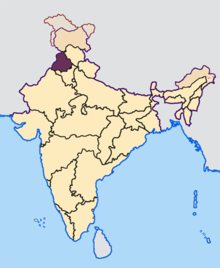Punjabi Christians
Punjabi Christians are ethnic Punjabis who are followers of Christianity. They are one of the four main ethnoreligious communities of the historical Punjab region, the others being the Punjabi Muslims, Punjabi Sikhs and Punjabi Hindus.[4] Like their ethnic kinsmen of other faiths, the Punjabi Christians are divided into various castes.[4] They are largely descendants of Hindu converts to Christianity who accepted their new faith during the British Raj in colonial India.[5]
 A group of Punjabi Christian villagers (2006) | |
| Total population | |
|---|---|
| c. 3,500,000 | |
| Regions with significant populations | |
| 3,000,000[1] | |
| 350,000[2] | |
| c. 17,000[3] | |
| Languages | |
| Religion | |
| Christianity | |
| Related ethnic groups | |
There are an estimated three million Christians living in the Pakistani province of Punjab, comprising 75 percent of the Christian population in Pakistan.[1][6][7] They are the second largest religious community in the province, forming approximately 1.5 to 2.8 percent of its population.[8][9] They are equally divided between Catholics and Protestants.[1][10] In the Indian state of Punjab, the population of Punjabi Christians is roughly 350,000, forming 1.26 percent of its population according to official figures.[2]
History
From the mid-19th to early 20th centuries, a number of Christian texts were translated and made widely available in the Punjabi language, such as the New Testament, the Gospel, and texts relating to Jesus.[11] Ninety-five percent of Punjabi Christians are converts to Christianity from Hinduism, accepting their new faith during the British Raj in colonial India.[5] By 1870, there were only a few thousand Christians in the Punjab Province of colonial India; the 1880s saw the growth of the Presbyterian Church from 660 to 10,615 baptized Christians.[12] Continued evangelism efforts by Christian missionaries, especially those from the Church of Scotland and Church Missionary Society in India led to nearly half a million Punjabi Christians by the 1930s.[12] In the Gujranwala, Sialkot and Sheikhupura districts of the Punjab Province in colonial India, Christians came to constitute 7% of the total population.[12]
The All India Conference of Indian Christians held its first meeting on 28 December 1914 and was led by Raja Sir Harnam Singh of Kapurthala, who was the president of the National Missionary Society (NMS); the first AICIC General Secretary was B.L. Rallia Ram of Lahore.[13][14] The meeting of the All India Conference of Indian Christians in Lahore in December 1922, which had a large attendance of Punjabis, resolved that the clergymen of the Church in India should be drawn from the ranks of Indians, rather than foreigners.[15] The AICIC also stated that Indian Christians would not tolerate any discrimination based on race or skin colour.[15] S. K. Datta of Lahore, who served as the principal of Forman Christian College in then colonial India, became the president of the All India Conference of Indian Christians, representing the Indian Christian community at the Second Round Table Conference, where he agreed with Mahatma Gandhi's views on minorities and Depressed Classes.[16]
In June 1947, the total population of Punjabi Christians in the Punjab Province of colonial India was recorded at 511,299. Of these, 450,344 were based in West Punjab and 60,955 were in East Punjab.[7] After the partition of British India, most Punjabi Christians remained in place, with the majority finding themselves within the borders of Pakistan and the rest in independent India.[17] Those Christians who were serving in official government positions and the civil service were given the choice of opting for either of the countries.[18] The many British-era churches and cathedrals dotting the various cities of Punjab were overtaken by Punjabi Christians, and they also continued the legacy of maintaining Christian educational institutions and healthcare facilities which had remained nationally renowned.[19]
Culture
| Part of a series on the |
| Punjabis |
|---|
 |
|
|
Asia
Europe North America Oceania |
|
Culture |
|
Punjab portal |
According to Selva J. Raj, the Punjabi Christian identity is an amalgamation of the Christian faith along with an ethnic affinity for the culture of Punjab, which includes the Punjabi language, Punjabi cuisine, the various customs and traditions of Punjab, and the way of life of the Punjabi people in general.[20]
As a result of living close to Punjabis of other faiths for generations, there have been notable cross-cultural influences; the Urdu language for instance, partly due to its evolution under Muslim presence in Punjab and otherwise due to its official adoption by the British Raj later on,[21] features heavily in the theology and literature of Punjabi Christians.[17] The earliest Christian scriptures which were published by British missionaries in the Punjab included those written in Roman Urdu.[21]
Geographical distribution
Pakistan
As of 1981, Lahore was the city with the largest Christian population in Pakistan, numbering over 200,000. The cities of Faisalabad, Sialkot and Sheikhupura are home to sizable communities.[22] In rural Punjab, many Christians belong to the Dalit Christian community, specifically the chuhra community,[23] whose ancestors had converted to Christianity from Hinduism during the colonial era to escape a discriminatory caste system in which they were regarded untouchables.[22][8][5][24][7] According to Dawn, compared to the more affluent Pakistani Christian communities of Anglo-Indians and Goan Catholics, who at the time of independence lived in the major cities, were proficient in English, and maintained upper-class British cultural mannerisms, the chuhras reflected the lower socioeconomic end of Pakistan; they were predominately labourers and peasants who were unskilled, did not own land, were neither highly educated or wealthy, and lived in the villages of central Punjab.[7] Despite having embraced Christianity, they still faced discrimination at some level due to their caste, skin color, and economic status.[7] Peter C. Phan states that these chuhras form the vast majority of Pakistani Christians.[5] There continue to be several Christian-majority villages and settlements throughout Pakistani Punjab, such as Clarkabad and Martinpur.[22] The Christians belonging to the lower-income strata of Pakistani society face a number of social and economic issues, such as bonded labour.[7][8] Because of their impoverishment, many of them are forced to work in menial labour jobs, such as cleaners and sweepers; in Punjab alone, an estimated 80 percent of all sanitation workers belong to the Christian community.[8] As a result of urbanisation, employment-driven migration into larger cities and greater educational opportunities, an increasing number of Punjabi Christians have been able to gain a college education and acquire socially respectable positions in recent times.[19]
In the Islamabad Capital Territory, the Christian community dwells in large numbers in Francis Colony, a legally-recognised residential area situated in sector F-7. Others live in slums (katchi abadis) located on government-owned land, to where they have shifted from Narowal, Shakargarh, Sheikhupura, Kasur, Faisalabad, Sahiwal and Sialkot in Punjab.[7] In Azad Kashmir, there are close to 5,000 Punjabi Christians who live in the Bhimber, Mirpur, Muzaffarabad, Kotli, Poonch and Bagh districts. Their roots lie mostly in Rawalpindi and Sialkot.[25] Most of the 50,000 or so Christians in Khyber Pakhtunkhwa speak Punjabi, and had ancestors who settled in this area, but have gradually become Pashtunized over time due to cultural assimilation.[26][22][7] The largest Christian population is in Peshawar,[22] and there are a few hundred Christians in Swat.[7] The districts forming the erstwhile tribal areas along the Afghan frontier have been home to thousands of Christians since the early 20th century; according to the 1998 census, there were 1,500 Christians in South Waziristan, 2,000 in North Waziristan, 500 in Bajaur, 700 in Mohmand and 1,500 in Khyber District, all of whose ancestors migrated from Punjab.[7] They primarily work in nursing, teaching, cleaning or in clerical jobs.[7]
In Sindh, there have been Punjabi Christians settled for several decades; they include farmers, landowners, agricultural workers and other labourers engaged in blue collar work in the rural countryside, with Catholic villages existing in Hyderabad, Nawabshah, Sanghar and Mirpur Khas.[27][7] The metropolis of Karachi is home to the largest population, with over 20,000 Punjabi Christians living in the neighbourhood of Essa Nagri alone.[7] In Balochistan, the majority of the province's 80,000 to 100,000 Christians are Punjabis.[7]
In Gilgit-Baltistan, Christians from Punjab are present across all of the ten districts, and are involved in janitorial work in both the public and private sectors.[24]
India
In India, the majority of Punjabi Christians belong to the Dalit community of chuhras[28] and belong to the lower-income working class.[23][2] At just over one percent of Punjab's population, their main population centres include the Gurdaspur, Amritsar, Firozpur, Jalandhar and Ludhiana districts.[11][29] There have historically been Punjabi Christian communities in Jammu,[23] Delhi,[23][30] and in Chandigarh, where the Christians are also known as Isai and belong to various sects. The Punjabi Christians in Chandigarh often bear the surname Masih.[31] Likewise in Haryana, some of the Christians settled there are Punjabis and are also commonly referred to as the Isai.[32] Both Chandigarh and Haryana were a part of Punjab up until 1966, when they were carved out as a separate union territory and state respectively.[31][32]
Diaspora
As a result of immigration, a large Christian Punjabi diaspora exists today.[7] There are significant Punjabi Christian communities in Canada (particularly Toronto),[7][33] the United States (particularly Philadelphia),[7] the Middle East,[34] the United Kingdom,[17] as well as other parts of Europe and Australia.[7] In the UK, Christian Punjabis are concentrated in the cities of London, Bedford, Birmingham, Coventry, Oxford and Wolverhampton among others.[20] One of the most prominent early Punjabi Christians in the UK was Duleep Singh, who first landed in the country in 1854.[20]
Some who have sought to resettle in the West have used Thailand, Sri Lanka and Malaysia as their first destinations, where they file an application with the UNHCR.[7] There have been concerns of irregular immigration among the community, to places such as China.[35][36] The primary motives for emigration include economic reasons, higher education, the desire to join relatives already settled abroad, theological training, or to escape religious discrimination/persecution.[7]
References
- Douglas Jacobsen (21 March 2011). The World's Christians: Who they are, Where they are, and How they got there. John Wiley & Sons. pp. 112–. ISBN 978-1-4443-9729-1.
- "Christians seek political voice in India's Punjab state". UCA News. 7 May 2019. Retrieved 15 April 2020.
- "2011 UK Census data - Religion". Office for National Statistics. 2011. Retrieved 4 October 2018.
- Anshu Malhotra; Farina Mir (21 February 2012). Punjab Reconsidered: History, Culture, and Practice. OUP India. pp. 352–. ISBN 978-0-19-908877-5.
- Phan, Peter C. (2011). Christianities in Asia. John Wiley & Sons. p. 25. ISBN 978-1-4443-9260-9.
- Weber, Jeremy (7 August 2009). "Were Pakistan's Deadly Gojra Riots Enough to Provoke Change?". Christianity Today. Retrieved 15 April 2020.
Punjab is the center of Pakistan's small Christian community—an estimated 3 million in the Muslim nation of 175 million...
- Aqeel, Asif; Faruqi, Sama (26 February 2018). "Caste away: The ongoing struggle of Punjabi Christians". Dawn. Retrieved 15 April 2020.
- Aqeel, Asif (23 October 2015). "'Christians required only as sweepers'". The Friday Times. Retrieved 16 April 2020.
- Edward P. Lipton (2002). Religious Freedom in Asia. Nova Publishers. pp. 40–. ISBN 978-1-59033-391-4.
- Gerard Mannion (25 November 2008). Church and Religious 'Other'. A&C Black. pp. 88–. ISBN 978-0-567-03286-7.
- Augustine Kanjamala (21 August 2014). The Future of Christian Mission in India: Toward a New Paradigm for the Third Millennium. Wipf and Stock Publishers. pp. 128–. ISBN 978-1-63087-485-8.
- Cox, Jeffrey (2002). Imperial Fault Lines: Christianity and Colonial Power in India, 1818-1940. Stanford University Press. ISBN 978-0-8047-4318-1.
- Thomas, Abraham Vazhayil (1974). Christians in Secular India. Fairleigh Dickinson Univ Press. p. 106-110. ISBN 978-0-8386-1021-3.
- Chatterjee, N. (2011). The Making of Indian Secularism: Empire, Law and Christianity, 1830-1960. Springer. p. 224. ISBN 978-0-230-29808-8.
- Webster, John C. B. (2018). A Social History of Christianity: North-west India since 1800. Oxford University Press. ISBN 978-0-19-909757-9.
In December 1921, the Punjabi-dominated meetings of the All India Conference of Indian Christians in Lahore was more cautious in their proposals but less cautious in the rationale they offered. They passed resolutions, first indicating that the Protestant missions 'should be completely merged in the Indian Church and that in future all Foreign Missionaries should be related to it', and then urging the missions in the meantime to 'appoint Indians of ability and character on an increasing scale'. Among their supporting arguments were that 'Indian Christians are not going to put up with colour and racial distinctions', that foreign missionaries could not solve the community's problems 'because of lack of sympathy', that the missions were too divided by denominational differences to bring about a united Indian Church, and that 'In these days Indians look up to Indians and do not pay much attention to foreigners.'
- Black, Brian; Hyman, Gavin; Smith, Graham M. (2014). Confronting Secularism in Europe and India: Legitimacy and Disenchantment in Contemporary Times. A&C Black. p. 88-91. ISBN 978-1-78093-607-9.
- Journal of Religious Studies. Department of Religious Studies, Punjabi University. 1986. p. 59.
Most Punjabi Christians remained on the Pakistani side. Emigration especially to U.K. has taken a tremendous toll. In U.K. they have sunk into the general mass of the British irreligious. On the Indian side, Punjabi Christians found how much they had been influenced by Islam.
- Bangash, Yaqoob Khan (5 January 2020). "When Christians were partitioned in the Punjab-IV". The News. Retrieved 16 April 2020.
- Chad M. Bauman; Richard Fox Young (7 August 2014). Constructing Indian Christianities: Culture, Conversion and Caste. Routledge. pp. 182–. ISBN 978-1-317-56027-2.
- Selva J. Raj (1 April 2016). South Asian Christian Diaspora: Invisible Diaspora in Europe and North America. Routledge. pp. 44–. ISBN 978-1-317-05229-6.
- Farina Mir (2010). The Social Space of Language: Vernacular Culture in British Colonial Punjab. University of California Press. ISBN 978-0-520-26269-0.
- Daniel Philpott; Timothy Samuel Shah (15 March 2018). Under Caesar's Sword: How Christians Respond to Persecution. Cambridge University Press. pp. 230, 232–. ISBN 978-1-108-42530-8.
- Webster, John C.B. "Punjabi Christians" (PDF). UC Santa Barbara & Union Theological Seminary. Retrieved 15 April 2020.
- Aqeel, Asif (1 November 2018). "'Untouchable' caste identity haunts Pakistani Christians like Asia Bibi". World Watch Monitor. Retrieved 16 April 2020.
- "The Plight of Minorities in 'Azad Kashmir'". Asian Lite. 14 January 2019. Archived from the original on 15 April 2020. Retrieved 15 April 2020.
Christians are the only community who migrated here from the Punjab, mostly from Rawalpindi and Sialkot.
- Usman, Ali (22 April 2013). "Multi-tongued: Peshawar's happy Hindus and Sikhs". The Express Tribune. Retrieved 15 April 2020.
- "Punjabi Christians leaving Sindh". UCA News. 27 November 1989. Retrieved 16 April 2020.
- Indian Church History Review. Church History Association of India. 2003. p. 66.
As Punjabi Christians in India, the vast majority of whom are from Chuhra backgrounds, reaffirm their Dalit identity along with their Christian identity..
- "India: Christians in shock after pastor shot dead in 'safe' Punjab". World Watch Monitor. 17 July 2017. Retrieved 16 April 2020.
- Kumar Suresh Singh (1998). India's Communities. Oxford University Press. p. 2882. ISBN 978-0-19-563354-2.
The Punjabi of Delhi mainly belong to four main religions, Hinduism, Sikhism, Islam and Christianity.
- Kumar Suresh Singh; V. Bhalla; Swaran Singh (1 January 1997). Chandigarh. Anthropological Survey of India. p. 47. ISBN 978-81-7304-119-8.
The Christians of Chandigarh, also known as Isai, have a number of sects... There are no accepted titles used by the community, but many Christian migrants from Punjab use Massey with their names.
- Madan Lal Sharma; A. K. Bhatia; Anthropological Survey of India (1994). Haryana. Anthropological Survey of India. p. 126. ISBN 978-81-7304-091-7.
The Christians in Haryana are numerically small and are popularly known as Issai. Most of them who setded in Haryana are not the original inhabitants of this place. They have migrated to this region from Bengal, Punjab, Kerala, Karnataka and Andhra Pradesh... Therefore, their food habits, language, festivals, religious faith etc. reflect the impact of the place of their original inhabitation. For example, the Christians of Kerala speak Malayalam; of Karnataka, Kannada; and those from Punjab, Punjabi.
- "Punjabi Christian community finally gets own church in Surrey". Hindustan Times. 20 February 2014. Retrieved 15 April 2020.
- Masudi, Faisal (17 December 2014). "Dubai's Pakistani Christians pray for Peshawar attack victims". Gulf News. Retrieved 15 April 2020.
- Gannon, Kathy (4 December 2019). "629 Pakistani Girls Trafficked to China as Brides". Christianity Today. Retrieved 16 April 2020.
- Gannon, Kathy; Kang, Dake (8 May 2019). "Pakistani Christian girls trafficked to China as brides". AP News. Retrieved 16 April 2020.
Further reading
- Webster, John C. B. "Punjabi Christians" (PDF). University of California, Santa Barbara & Union Theological Seminary.


